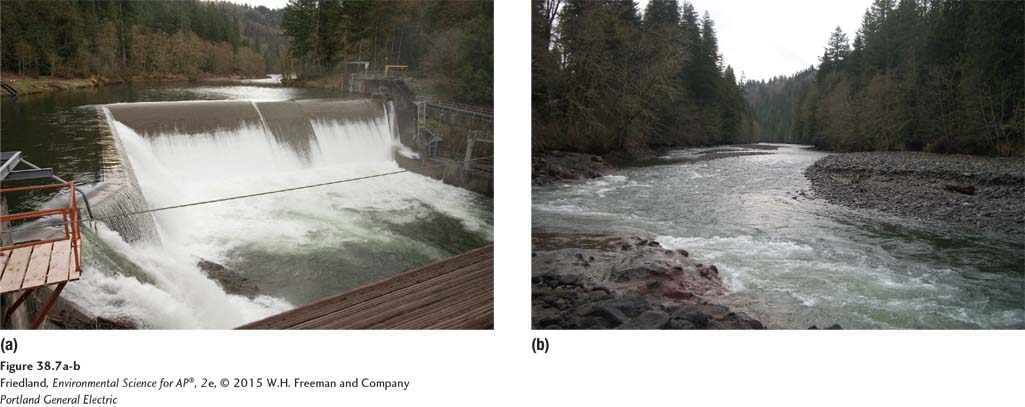module 38 Biomass and Water
As we discussed in Chapter 12, the Sun is the ultimate source of fossil fuels. Fossil fuels are created from dead plants and animals that are buried deep in sediments and that are slowly transformed into petroleum or coal. Most types of renewable energy are also derived from the Sun and cycles driven by the Sun, including solar, wind, and hydroelectric energy as well as plant biomass such as wood. In this module, we present two important renewable energy sources: biomass and water.
Learning Objectives
After reading this module you should be able to
describe the various forms of biomass.
explain how energy is harnessed from water.
Biomass is energy from the Sun
Biofuel Liquid fuel created from processed or refined biomass.
As FIGURE 38.1 shows, all fossil fuel and most renewable energy sources ultimately come from the Sun. Biomass energy resources encompass a large class of fuel types that include wood and charcoal, animal products and manure, plant remains, and municipal solid waste (MSW), as well as liquid fuels such as ethanol and biodiesel. Many forms of biomass used directly as fuel, such as wood and manure, are readily available all over the world. Because these materials are inexpensive and abundant, they account for more than 10 percent of world energy consumption (see FIGURE 37.6), with a much higher percentage in many developing countries. Biomass can also be processed or refined into liquid fuels such as ethanol and biodiesel, known collectively as biofuels. These fuels are used in more limited quantities due to the technological demands associated with their use. For example, it is easier to burn a log in a fire than it is to develop the technology to produce a compound such as ethanol.
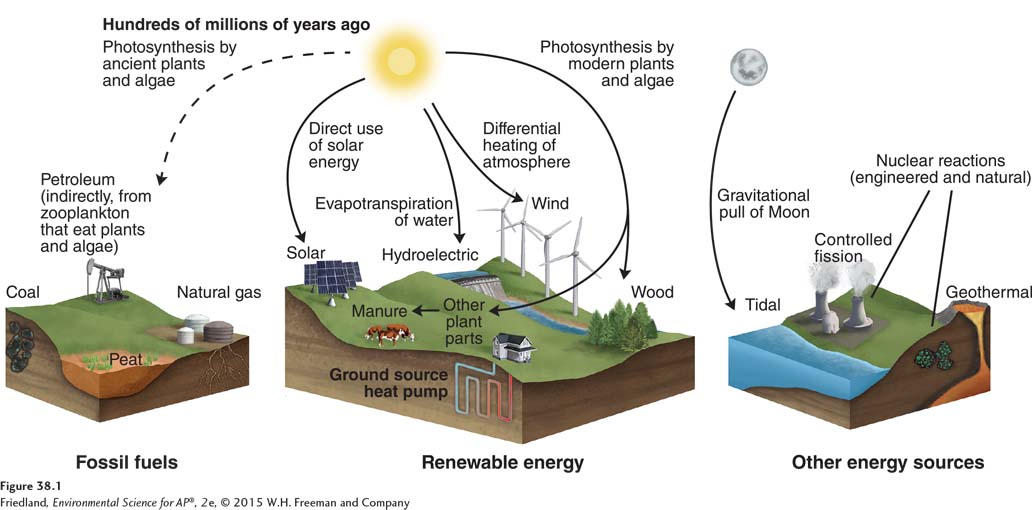
Biomass—
Modern Carbon versus Fossil Carbon
Modern carbon Carbon in biomass that was recently in the atmosphere.
Fossil carbon Carbon in fossil fuels.
Like fossil fuels, biomass contains a great deal of carbon, and burning it releases that carbon into the atmosphere. Given the fact that both fossil fuels and biomass raise atmospheric carbon concentrations, is it really better for the environment to replace fossil fuels with biomass? The answer depends on how the material is harvested and processed and on how the land is treated during and after harvest. It also depends on how long the carbon has been stored. The carbon found in plants growing today was in the atmosphere in the form of carbon dioxide until recently when it was incorporated into the bodies of the plants through photosynthesis. Depending on the type of plant it comes from, the carbon in biomass fuels may have been captured through photosynthesis as recently as a few months ago, as in the case of a corn plant, or perhaps up to several hundred years ago, as in the case of wood from a large tree. We call the carbon in biomass modern carbon, in contrast to the carbon in fossil fuels, which we call fossil carbon.
Carbon neutral An activity that does not change atmospheric CO2 concentrations.
Unlike modern carbon, fossil carbon has been buried for millions of years. Fossil carbon is carbon that was out of circulation until humans discovered it and began to use it in increasing quantities. The burning of fossil fuels results in a rapid increase in atmospheric CO2 concentrations because we are unlocking or releasing stored carbon that was last in the atmosphere millions of years ago. In theory, the burning of biomass (modern carbon) should not result in a net increase in atmospheric CO2 concentrations because we are returning the carbon to the atmosphere, where it had been until recently. And, if we allow vegetation to grow back in areas where biomass was recently harvested, that new vegetation will take up an amount of CO2 more or less equal to the amount we released earlier by burning the biomass. Over time, the net change in atmospheric CO2 concentrations should be zero. An activity that does not change atmospheric CO2 concentrations is referred to as carbon neutral.
Whether using biomass is truly carbon neutral, however, is an important question that is currently being discussed by scientists and policy makers. Sometimes the use of modern carbon ends up releasing CO2 into the atmosphere that would otherwise have remained in the soil or in fossil fuels.
Solid Biomass: Wood, Charcoal, and Manure
Throughout the world, 2 billion to 3 billion people rely on wood for heating or cooking. In the United States, approximately 3 million homes use wood as the primary heating fuel, and more than 20 million homes use wood for energy at least some of the time. In addition, the pulp and paper industries, power plants, and other industries use wood waste and by-
Net removal The process of removing more than is replaced by growth, typically used when referring to carbon.
Removing more timber than is replaced by growth, or net removal of forest, is an unsustainable practice that will eventually lead to deforestation. This net removal of forest together with the burning of wood results in a net increase in atmospheric CO2: The CO2 released from the burned wood is not balanced by photosynthetic carbon fixation that would occur in new tree growth. Harvesting the forest may also release carbon from the soil that would otherwise have remained buried deep in the A and B horizons. Although the mechanism is not entirely clear, it appears that some of this carbon release may occur because logging equipment disturbs the soil.
Tree removal can be sustainable if we allow time for forests to regrow. In addition, in some heavily forested areas, extracting individual trees of abundant species and opening up spaces in the canopy will allow other plants to grow and increase habitat diversity, which may even increase total photosynthesis. More often, however, tree removal has the potential to cause soil erosion, to increase water temperatures in nearby rivers and streams, and to fragment forest habitats when logging roads divide them. Tree removal may also harm species that are dependent on old-
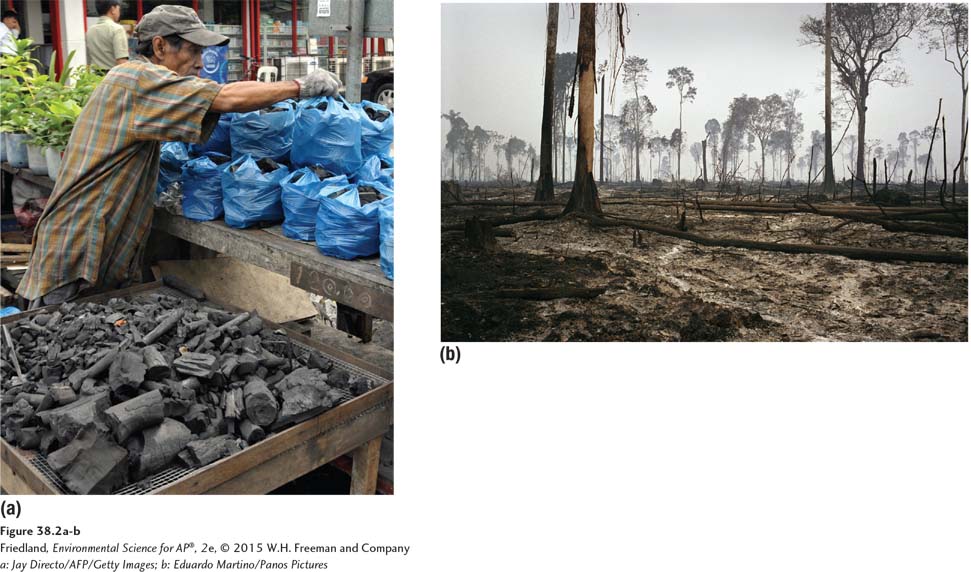
Many people in the developing world use wood to make charcoal, which is a superior fuel for many reasons. Charcoal is lighter than wood and contains approximately twice as much energy per unit of weight. A charcoal fire produces much less smoke than wood and does not need to be tended constantly, as does a wood fire. Although it is more expensive than wood, charcoal is a fuel of choice in urban areas of the developing world and for families who can afford it. However, harvesters who clear an area of land for charcoal production often leave it almost completely devoid of trees (FIGURE 38.2).
In regions where wood is scarce, such as parts of Africa and India, people often use dried animal manure as a fuel for indoor heating and cooking. Burning manure can be beneficial because it removes harmful microorganisms from surrounding areas, which reduces the risk of disease transmission. However, burning manure also releases particulate matter and other pollutants into the air that cause a variety of respiratory illnesses, from emphysema to cancer. The problem is exacerbated when the manure is burned indoors in poorly ventilated rooms, a common situation in many developing countries. The World Health Organization estimates that indoor air pollution is responsible for nearly 2 million deaths annually. Chapters 15 and 17 cover indoor air pollution and human health in more detail.
Whether indoors or out, burning biomass fuels produces a variety of air pollutants, including particulate matter, carbon monoxide (CO), and nitrogen oxides (NOx), which are important components of air pollution (FIGURE 38.3).

Biofuels: Ethanol and Biodiesel
Ethanol Alcohol made by converting starches and sugars from plant material into alcohol and CO2.
Biodiesel A diesel substitute produced by extracting and chemically altering oil from plants.
The liquid biofuels—
Ethanol
The United States is the world leader in ethanol production, manufacturing more than 50 billion liters (13.3 billion gallons) in 2012. Brazil, the world’s second largest ethanol producer, is making biofuels a major part of its sustainable energy strategy. Brazil manufactures ethanol from sugarcane, which is easily grown in its tropical climate. Unlike corn, which must be replanted every year, sugarcane is replanted every 6 years and is sometimes harvested by hand, factors that reduce the amount of fossil fuel energy needed.
Flex-
Ethanol is usually mixed with gasoline, most commonly at a ratio of one part ethanol to nine parts gasoline. The result is gasohol, a fuel that is 10 percent ethanol. Gasohol has a higher oxygen content than gasoline alone and produces less of some air pollutants when combusted. In certain parts of the midwestern United States, especially in corn-
Proponents of ethanol claim that it is a more environmentally friendly fuel than gasoline, although opponents dispute that claim. Ethanol does have disadvantages. The carbon bonds in alcohol have a lower energy content than those in gasoline, which means that a 90 percent gasoline/10 percent ethanol mix reduces gas mileage by 2 to 3 percent when compared with 100 percent gasoline fuel. As a result, a vehicle needs more gasohol to go the same distance it could go on gasoline alone. Furthermore, growing corn to produce ethanol uses a significant amount of fossil fuel energy, as well as land that can otherwise be devoted to growing food. Ethanol production has led to concern among economic analysts that this periodically contributes to short-
Research is under way to find viable alternatives to corn as sources for U.S. ethanol production. Switchgrass is one possibility. It is a perennial crop, which means that farmers can harvest it without replanting, minimizing soil disturbance and erosion. Furthermore, switchgrass does not require as much fossil fuel input as corn to produce. However, crops such as corn and sugarcane produce ethanol more readily due to their high sugar content because sugars are readily and rapidly converted into ethanol. In contrast, switchgrass and other alternative materials, such as wood chips, are composed primarily of cellulose—
Biodiesel
Biodiesel is a direct substitute for petroleum-
Because biodiesel tends to solidify into a gel at low temperatures, higher concentrations of biodiesel work effectively only in modified engines. However, with a kit sold commercially, a skilled individual or automobile mechanic can modify any diesel vehicle to run on 100 percent straight vegetable oil (SVO), typically obtained as a waste product from restaurants and filtered for use as fuel. Groups of students in the United States have driven buses around the country almost exclusively on SVO, and some municipalities, such as Portland, Maine, have community-
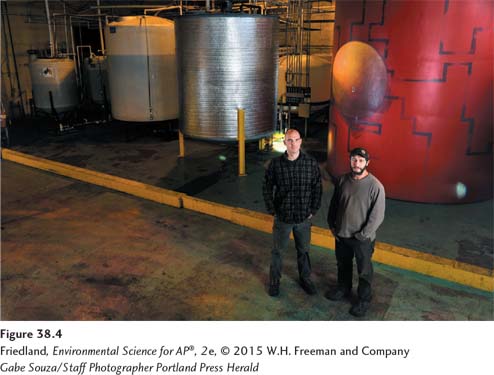
In the United States, most biodiesel comes from soybean oil or processed vegetable oil. However, scientists are working on ways to produce large quantities of biodiesel directly from wood or other forms of cellulose—
Emissions of carbon monoxide from combustion of biodiesel are lower than those from petroleum diesel. Since it contains modern carbon rather than fossil carbon, biodiesel should be carbon neutral, although, as with ethanol, some critics question whether biodiesel is truly carbon neutral. For instance, producing biodiesel from soybeans requires less fossil fuel input per liter of fuel than producing ethanol from corn, but soybeans require more cropland, and so they may actually transfer more carbon from the soil to the atmosphere. In contrast, producing biodiesel from wood waste or algae may require very little or no cropland and a minimal amount of other land.
The kinetic energy of water can generate electricity
Hydroelectricity Electricity generated by the kinetic energy of moving water.
Hydroelectricity is electricity generated by the kinetic energy of moving water. It is the second most commonly used form of renewable energy in the United States and in the world, and it is the form most widely used for electricity generation. As we saw in Chapter 12 (FIGURE 34.8 on page 407), hydroelectricity accounts for approximately 7 percent of the electricity generated in the United States. More than one-
Methods of Generating Hydroelectricity
Moving water, either falling over a vertical distance or flowing with a river or tide, contains kinetic energy. A hydroelectric power plant captures this kinetic energy and uses it to turn a turbine in the same way that the kinetic energy of steam turns a turbine in a coal-
The amount of electricity that can be generated at any particular hydroelectric power plant depends on the flow rate, the vertical distance the water falls, or both. Where falling water is the source of the energy, the amount of electricity that can be generated depends on the vertical distance the water falls; the greater the distance, the more potential energy the water has, and the more electricity it can generate (see FIGURE 5.2 on page 45). The amount of electricity a hydroelectric power plant can generate also depends on the flow rate: the amount of water that flows past a certain point per unit of time. The higher the flow rate, the more kinetic energy is present, and the more electricity can be generated.
Run-
Run-
In run-
Water Impoundment Systems
Water impoundment The storage of water in a reservoir behind a dam.
Storing water in a reservoir behind a dam is known as water impoundment. FIGURE 38.5 illustrates the various features of a water impoundment system. By managing the opening and closing of the gates, the dam operators control the flow rate of the water that turns the turbine—
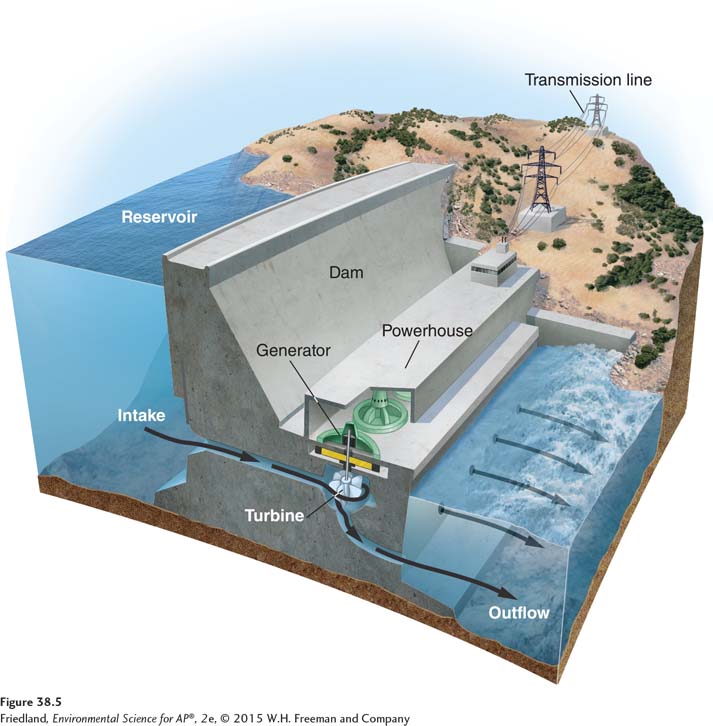
Water impoundment is the most common method of hydroelectricity generation because it usually allows for the generation of electricity on demand. The largest hydroelectric water impoundment dam in the United States is the Grand Coulee Dam in Washington State, which generates 6,800 MW at peak capacity. The Three Gorges Dam on the Yangtze River in China (see FIGURE 27.2, page 304) is the largest dam in the world. It has a capacity of 18,000 MW and can generate almost 85 billion kilowatt-
Tidal Systems
Tidal energy Energy that comes from the movement of water driven by the gravitational pull of the Moon.
Tidal energy also comes from the movement of water, although the movement in this case is driven by the gravitational pull of the Moon. Tidal energy systems use gates and turbines similar to those used in run-
Although tidal power plants are operating in many parts of the world, including France, Korea, and Canada, tidal energy does not have the potential to become a major energy source. In many places the difference in water level between high and low tides is not great enough to provide sufficient kinetic energy to generate a large amount of electricity. In addition, to transfer the energy generated, transmission lines must be constructed on or near a coastline or estuary. This infrastructure may have a disruptive effect on coastal, shoreline, and marine ecology as well as on tourism that relies on the aesthetics of a coastal region.
Hydroelectricity and Sustainability
Major hydroelectric dam projects have brought renewable energy to large numbers of rural residents in many countries, including the United States, Canada, India, China, Brazil, and Egypt. Although hydroelectric dams are expensive to build, once built, they require a minimal amount of fossil fuel for operation. In general, the benefits of water impoundment hydroelectric systems are great: They generate large quantities of electricity without creating air pollution, waste products, or CO2 emissions. Electricity from hydroelectric power plants is usually less expensive for the consumer than electricity generated using nuclear fuels or natural gas. In the United States, the price of hydroelectricity ranges from 5 cents to 11 cents per kilowatt-
In addition, the reservoir behind a hydroelectric dam can provide recreational and economic opportunities as well as downstream flood control for flood-
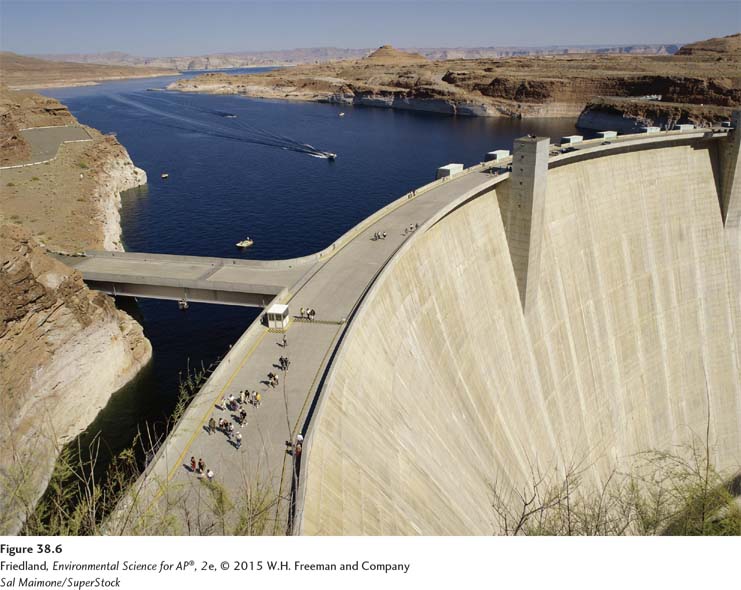
Water impoundment, however, does have negative environmental consequences. In order to form an impoundment, a free-
By regulating water flow and flooding, dams also alter the dynamics of the river ecosystem downstream. Some rivers, for example, have sandbars created during periods of low flow that follow periods of flooding. Some plant species, such as cottonwood trees, cannot reproduce in the absence of these sandbars. The life cycles of certain aquatic species, such as salmon, certain trout species, and freshwater clams and mussels, also depend on seasonal variations in water flow. Impoundment systems disrupt these life cycles by controlling the flow of water so it is consistently plentiful for hydroelectricity generation.
It is possible to address some of these problems. For example, as we saw in Chapter 9, the installation of a fish ladder (see FIGURE 27.3 on page 304) may allow fish to travel upstream around a dam. Such solutions are not always optimal, however; some fish species fail to utilize them and some predators learn to monitor the fish ladders for their prey.
Other environmental consequences of water impoundment systems include the release of greenhouse gases to the atmosphere, both during dam construction and after filling the reservoir. Production of cement—
Siltation The accumulation of sediments, primarily silt, on the bottom of a reservoir.
The accumulation of sediments in reservoirs has negative consequences not only for the environment but also for the electricity-
Because of either environmental concerns or heavy siltation, a number of hydroelectric dams are being dismantled, as we saw at the beginning of Chapter 9. In 1999, the Edwards Dam was removed from the Kennebec River in Maine. More than a decade later, native fishes such as bass and alewives have returned to the waters and are flourishing. In 2007, the Marmot Dam on Oregon’s Sandy River was removed using explosives. The restored river now hosts migrating salmon and steelhead trout (Oncorhynchus mykiss) for the first time since 1912 (FIGURE 38.7).
